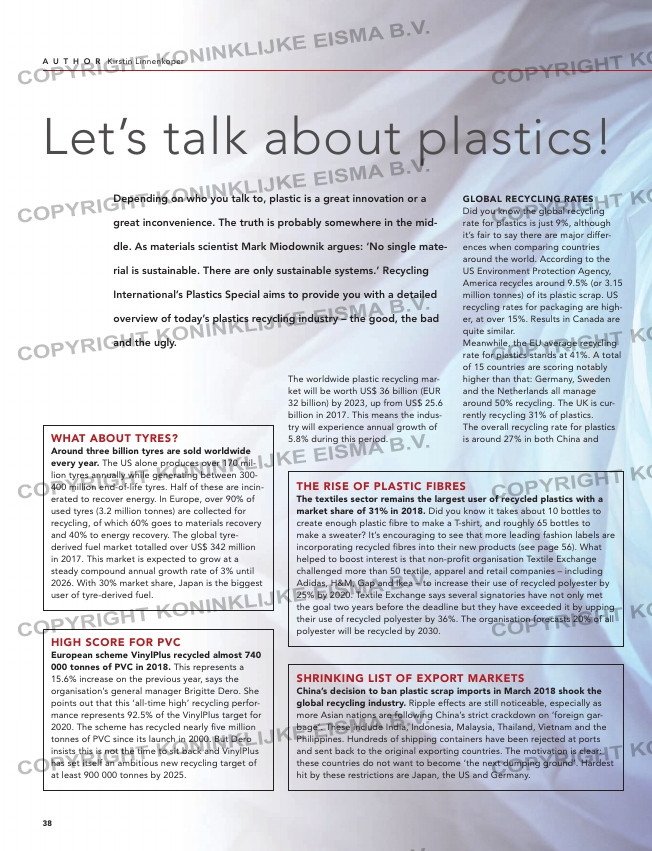Page 38 from: West Coast report + Plastics Special

A U T H O R Kirstin Linnenkoper
38
Let’s talk about plastics!
Depending on who you talk to, plastic is a great innovation or a
great inconvenience. The truth is probably somewhere in the mid-
dle. As materials scientist Mark Miodownik argues: ‘No single mate-
rial is sustainable. There are only sustainable systems.’ Recycling
International’s Plastics Special aims to provide you with a detailed
overview of today’s plastics recycling industry – the good, the bad
and the ugly.
Japan while Thailand manages around
25%. The outcome for Australia and
New Zealand is roughly 12% and 10%,
respectively. Meanwhile, African
nations like Ghana are recycling
approximately 5% of all plastic waste.
Figures for India are estimated to be
less than 10%.
Official Russian figures are vague; only
about 5% of all waste is recycled,
while the country landfills up to 90%
of its waste annually. Brazil is said to
recycle less than 2% of its plastics.
While Mexico’s overall recycling rate is
only 17%, the PET recycling rate is
over 57%.
HIGH DEMAND FOR PACKAGING
More than 60% of the PET bottles used
in Europe are recycled. However, the
recycling rate for bottles is only 25% in
developing countries like India while
China isn’t doing much better. On the
plus side, research firm Absolute
Market Insights reports that the global
recycled PET chips market will grow
4.5% during the 2018 – 2026 period.
More recycling capacity is likely to be
needed to cater to an ever-expanding
packaging market. Today, the packag-
ing sector generates US$ 900 billion
(EUR 805 billion) in annual revenues
worldwide, analysts at McKinsey &
Company point out. This is mostly
because of the big surge in food
packaging. They add that the demand
for meals-to-go will grow by 20.5%
between 2017 and 2022.
In fact, the whole packaging industry
is on track to keep growing at annual
rate of 3.1% until 2022. A full 70% of
this growth is coming from emerging
markets, McKinsey notes. While
growth in North America will increase
by 1.2% annually, markets in China
and India are growing at a rate of
5.2% and 5.8% annually. Analysts
note that retail sales in China are
already 80% higher than in the United
States.
The worldwide plastic recycling mar-
ket will be worth US$ 36 billion (EUR
32 billion) by 2023, up from US$ 25.6
billion in 2017. This means the indus-
try will experience annual growth of
5.8% during this period.
GLOBAL RECYCLING RATES
Did you know the global recycling
rate for plastics is just 9%, although
it’s fair to say there are major differ-
ences when comparing countries
around the world. According to the
US Environment Protection Agency,
America recycles around 9.5% (or 3.15
million tonnes) of its plastic scrap. US
recycling rates for packaging are high-
er, at over 15%. Results in Canada are
quite similar.
Meanwhile, the EU average recycling
rate for plastics stands at 41%. A total
of 15 countries are scoring notably
higher than that: Germany, Sweden
and the Netherlands all manage
around 50% recycling. The UK is cur-
rently recycling 31% of plastics.
The overall recycling rate for plastics
is around 27% in both China and
THE RISE OF PLASTIC FIBRES
The textiles sector remains the largest user of recycled plastics with a
market share of 31% in 2018. Did you know it takes about 10 bottles to
create enough plastic fibre to make a T-shirt, and roughly 65 bottles to
make a sweater? It’s encouraging to see that more leading fashion labels are
incorporating recycled fibres into their new products (see page 56). What
helped to boost interest is that non-profit organisation Textile Exchange
challenged more than 50 textile, apparel and retail companies – including
Adidas, H&M, Gap and Ikea – to increase their use of recycled polyester by
25% by 2020. Textile Exchange says several signatories have not only met
the goal two years before the deadline but they have exceeded it by upping
their use of recycled polyester by 36%. The organisation forecasts 20% of all
polyester will be recycled by 2030.
WHAT ABOUT TYRES?
Around three billion tyres are sold worldwide
every year. The US alone produces over 170 mil-
lion tyres annually while generating between 300-
400 million end-of-life tyres. Half of these are incin-
erated to recover energy. In Europe, over 90% of
used tyres (3.2 million tonnes) are collected for
recycling, of which 60% goes to materials recovery
and 40% to energy recovery. The global tyre-
derived fuel market totalled over US$ 342 million
in 2017. This market is expected to grow at a
steady compound annual growth rate of 3% until
2026. With 30% market share, Japan is the biggest
user of tyre-derived fuel.
SHRINKING LIST OF EXPORT MARKETS
China’s decision to ban plastic scrap imports in March 2018 shook the
global recycling industry. Ripple effects are still noticeable, especially as
more Asian nations are following China’s strict crackdown on ‘foreign gar-
bage’. These include India, Indonesia, Malaysia, Thailand, Vietnam and the
Philippines. Hundreds of shipping containers have been rejected at ports
and sent back to the original exporting countries. The motivation is clear:
these countries do not want to become ‘the next dumping ground’. Hardest
hit by these restrictions are Japan, the US and Germany.
HIGH SCORE FOR PVC
European scheme VinylPlus recycled almost 740
000 tonnes of PVC in 2018. This represents a
15.6% increase on the previous year, says the
organisation’s general manager Brigitte Dero. She
points out that this ‘all-time high’ recycling perfor-
mance represents 92.5% of the VinylPlus target for
2020. The scheme has recycled nearly five million
tonnes of PVC since its launch in 2000. But Dero
insists this is not the time to sit back and VinylPlus
has set itself an ambitious new recycling target of
at least 900 000 tonnes by 2025.
38-39_plasticsspecialintro.indd 38 08-08-19 11:09



